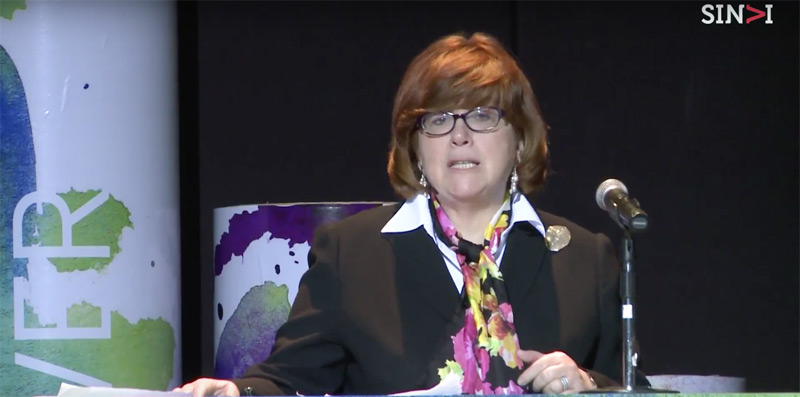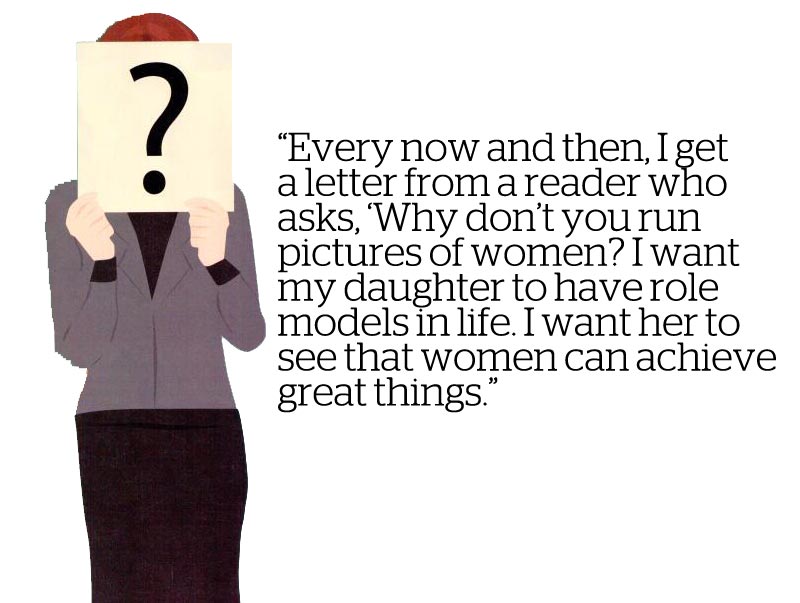For ultra-Orthodox newspapers, women and the Web present growing challenges......
DEHUMANIZING YOUR MOTHER, GRANDMOTHER, AND ALL THAT CAME BEFORE THEM!
“You open the Gannett paper and you find they are mocking you. They say you are an idiot.”... Well you are Pinny!
Occasionally, they will run a caricature of Hillary Clinton from a political cartoon, but not a photo.
It was one thing to avoid printing Clinton’s picture when she was First Lady or a United States senator, or even Secretary of State. But how can you not show the President of the United States?
In interviews, the editors of four major English-language ultra-Orthodox publications, three of them published in New York and one in Jerusalem, said that they are reevaluating their no-women policy in light of the Clinton candidacy, but would not make any final decisions alone. As with all important decisions, they will take the question to the boards of rabbinical advisors with whom final authority over the publications’ content rests. One of the editors, a rabbi himself, said that a Clinton victory could spell a change in the longstanding no-women policy in his paper and the others. “I think we’re going to have to rethink it,” Rabbi Yitzchok Frankfurter, the executive editor of Ami Magazine, told me. Not to do so, he said, “would be disrespectful.”

A September 9 issue of the Brooklyn-based daily
newspaper Hamodia features a lineup of male presidential candidates. To
the right, candidate Hillary Clinton appears not in a photo but in an
unflattering caricature.
The renewed discussion about women in these newspapers is a sign of
the resistance to change in the isolated world of ultra-Orthodox
journalism in the United States. Many of these publications are in
Hebrew and Yiddish, but those most attuned to the shifting landscape are
the four major English-language newspapers and magazines: Ami (“my people”), Hamodia (“the informer”), Mishpacha (“family”), and Yated Neeman
(“the faithful peg,” a reference to Isaiah 22:23, where the prophet
speaks of placing a divine servant as a “peg in a sure place.”) Taken
together, these four publications have a circulation of about 100,000.
Their mission, their editors say, is to provide “kosher news” for their
readers, who, as strictly observant Jews, are decidedly
counter-cultural. The papers do not print articles about celebrities,
avoid gossip, and steer clear of scandals and references to sex. You
won’t read here about Caitlin Jenner, Bill Cosby, Miley Cyrus, or the
latest crush on American Idol.It is a formula that is working. While mainstream print journalism has been in a downward spiral over the last 20 years, these publications have been experiencing a growth spurt in both number and circulation, in part because the internet—the very thing that has been killing traditional print journalism—is viewed with great suspicion by the ultra-Orthodox, who try to severely limit its use. In fact, there is one day, the Jewish Sabbath, when Orthodox Jews do not use computers at all—not for work, not for commerce, and not for pleasure. Among the ultra-Orthodox, the internet is seen as a dangerous and intrusive force whose use must be carefully monitored, even during the other six days of the week. Many ultra-Orthodox have “kosher filters” on their computers and cell phones that help them stave off what they see as negative influences of the outside world. Newspapers aren’t just a luxury; in this community, as in so many others before the advent of digital news, they are a necessity.
“I don’t think we’d survive one day without Shabbes,” Rabbi Frankfurter told me, using the Yiddish word for the Sabbath.
There are, of course, also contradictions and surprises in this world of Orthodox journalism. One is that even though they won’t run photos of women, the papers are largely run by women, who by and large have stronger secular educations than ultra-Orthodox men. The publisher of Hamodia, for example, is Ruth Lichtenstein whose father, a rabbi, edited a Hebrew version of the paper in Israel in the 1950’s. Mrs. Lichtenstein founded the English language version in Brooklyn in 1998.
Lichtenstein runs the paper out of an office whose walls are adorned with portraits of her father and other bearded ancestor involved in ultra-Orthodox journalism. At the start of our interview, she turned to the wall and indicated her reverence for these men, saying, “I always say I have to give a report.” Like the character in the old Hebrew National commercial, she claims to answer to a higher authority.

Hamodia publisher Ruth Lichtenstein speaks last spring at Sinai Indaba, an annual Torah convention.
When I asked her about women, she said excluding them in photos was a matter of modesty. “Purity and modesty are natural to women, not public exposure,” she said. “It is unfortunate that modern times deny women this precious quality and instead turn them into objects.” She said that the paper’s policy not to publish women’s photos comes out of “respect for women’s rights for privacy and modesty.”
“We are backed by thousands of years of Jewish tradition,” she added. “We do not compromise our values.”
But even as she adheres to tradition, change is in the air. The publications have stepped gingerly into the digital age. They all have Websites, but these are more akin to mainstream newspaper Websites 10 or 15 years ago than today. They do not have a presence on Facebook or Twitter, and they do not enable readers to comment outside of traditional letters to the editor.
Yated Ne’eman, which can run over 100 pages a week, has only four or five articles on its homepage. It is primarily a place for visitors to subscribe to the print edition, promising readers $30 off a two-year subscription. Ami’s website has only headlines and pictures—and a paywall. “To get the rest of this article, please buy this issue or subscribe to Ami,” the site says.
Until recently, Hamodia’s website only offered readers the opportunity to “browse today’s print edition.” The paper now has a proper home page, but it is just an online version of the print paper. It is updated once a day.
When I first sat down with Lichtenstein in July, she told me that she was on the cusp of a big announcement about Hamodia’s website, rolling out a new product that would be updated “24/6,” the code that Orthodox use for full-time, minus the Sabbath. But the announcement still hasn’t come. “We’re not quite ready,” she said. But she assured me that it is going to happen in the near future.
She’s not alone in her hesitation. A year ago, one of the editors of Mishpacha, Eytan Kobre, was told to “drop everything” and come to Israel for an urgent meeting on rolling out an online edition, he told me. “I arrived and they changed their minds,” he said. “Nothing happened.” Like the other papers, Mishpacha has a website, but it’s mostly meant to attract print subscribers.
The only difference between The New York Times and us is that we make money.”
These publications invest heavily in their paper editions, which are beautifully done, often with glossy magazine supplements that include vivid color, professional photographs (many of food), and smart graphics. (A feature in Mishpacha, called “Day in the Life,” runs with arrows, dates, and photographs of ultra-Orthodox Jews with unusual professions, including a hypnotherapist.) There are opinion columns, Torah lessons, motivational stories, and even classified ads for apartments, cars, jobs, and matchmakers.
The papers are also carefully copy edited, something of a dying art at many mainstream publications. And they continue to attract advertisers who have few other ways of reaching their core readership. They are thick with ads for kosher food, vacations in Israel, Jewish schools, modest clothing, sacred texts, and fundraising pitches for a variety of charities and organizations. They have a healthy mix of subscription and newsstand sales.
There are an estimated 500,000 ultra-Orthodox Jews in the United States, according to Dr. Pearl Beck, a demographer with Ukeles Associates, Inc. She based the figure on a 2011 UJA-Federation survey that counted 336,000 in the New York area alone. The ultra-Orthodox make up 22 percent of New York area Jews and roughly 10 percent of Jews nationwide. New York, Baltimore, Cleveland, Miami, and Chicago are among the major cities where they live (and where these publications circulate). You can find these papers in kosher megastores in all these cities, like Seasons, Brach’s, Pomegranate, and EverGreen.
The combined circulation of the four publications is probably less than 100,000 but the editors say that readership is many times that number for two essential reasons: Orthodox Jews tend to have large families, and they have one day, the Jewish Sabbath, when they devote much of the day to reading. “Our readers spend hours and hours of time relaxing and rejuvenating with family,” said Shoshana Friedman, the editor of Mishpacha, a weekly that comes in three sections, one that has news and feature articles, a second for women (called “Family First”), and a third for children (simply called “Jr.” that also includes “Teen Pages”). In addition to news and features, there are serialized works of fiction, like the melodramatic “Flashback,” which runs episodically in Mishpacha. According to the summary of one recent installment: “Michal’s effort to get Ashi to talk about his relationship with his deceased father is only partially successful; Ashi reveals that it’s a painful subject but he promises he will never be like his father.”
“We like to think there is something for everyone,” said Friedman. “That’s people’s entertainment on Shabbes.”

There is also a community-building aspect to these publications. During times of tragedy, such as the freak Friday night fire that took the lives of seven children from a Brooklyn family in March, the publications rallied around the surviving family members. They raised money for the family, and published fire safety precautions to warn others.
“I’m proud of what we produce,” Rabbi Lipschutz said pointing to that week’s issue of the paper. He flipped it over. “One hundred and sixty-four pages, plus our magazine, which is another 56 pages.”
Like the other editors, Rabbi Lipschutz did not criticize his ultra-Orthodox competitors, but he did take a swipe at the local general interest newspaper, The Journal News, which he said is filled with celebrity news and other frivolous content. “You open the Gannett paper and you find they are mocking you. They say you are an idiot.”
At the same time, he admires The New York Times. On the day I visited, a well-read copy lay on his desk. He called it his “Bible.” “I read it every day,” he told me.
Some ultra-Orthodox criticize the Times for what they see as unfairness to Israel, but Lipschutz was more worried about what he views as its lavish expenditures. “It took three people to write that story on Greece?” he said pointing to the front page. “The only difference between The New York Times and us,” he said with a smile, “is that we make money.”
Yated Ne’eman, which Lipschutz founded in 1987, has a full-time staff of three; about a half dozen others come in on production days. It gets the bulk of its international news from JNS.org, a free news service that is an arm of Israel Today, a free daily newspaper in Israel owned by Sheldon Adelson, the American philanthropist and Las Vegas casino magnate. Israel Today, like the ultra-Orthodox papers, is unquestioning in its support of the right-leaning Prime Minister Benjamin Netanyahu.
Instead of movie stars, supermodels and sports figures, Yated and the other papers run photo after photo of bearded rabbis. In their columns, the rabbis answer readers’ questions about Jewish practice, education, personal interaction, and matrimony. “How do I get my husband to stop smoking?” one reader asked. “How do I get better results for my children from the matchmaker?” wondered another.
Purity and modesty are natural to women, not
public exposure. It is unfortunate that modern times deny women this
precious quality and instead turn them into objects.”
All of the editors said that the practice of not using women’s photographs started with the Israeli papers, which set the standard. Most of them said that the vast majority of their subscribers read other publications with pictures of women, but that they declined to use women’s pictures out of fear of alienating the more observant segment of their readership.
This leads to curious situations. For example, this summer Mishpacha had a cover story on Rachelle Frankel, the mother of one of three teenage boys murdered last summer in Israel, a killing that was part of the lead-up to the war in Gaza. The article talks about how Mrs. Frankel emerged as a spokeswoman for the bereaved and quotes her extensively. However, there are no photos of her or the other mothers; the only pictures are of her son and his fellow victims.
The women’s issue made headlines in 2011, when a Yiddish newspaper that serves the ultra-Orthodox community, Di Tzeitung, published in Brooklyn, digitally removed Mrs. Clinton from a picture of the White House situation room on the night of the military operation that assassinated Osama bin Laden. The English-language papers did not use Photoshop, but one of them, Ami, cropped her out of the picture. The picture the paper ran included the President, the Vice President, the Chairman of the Joint Chiefs of Staff, and the White House Chief of Staff, but not the Secretary of State.
While the editor of Di Tzeitung apologized for manipulating a White House photo, which is a violation of the licensing agreements, Rabbi Frankfurter of Ami defended his stance, saying that cropping is “done routinely by most papers and magazines.”
The ultra-Orthodox papers also managed to artfully crop Prime Minister Angela Merkel out of a picture of the huge rally in Paris after the murder of the Charlie Hebdo cartoonists.
But continually cropping out President Hillary Clinton might prove too much even for Rabbi Frankfurter. “We would be locking ourselves out of a lot of opportunities,” he said. “We couldn’t even run photos of the White House Hanukkah party.”
Members of the ultra-Orthodox community said that they saw no contradiction in the fact that the papers will not print photos of women, yet many of them are run by women. In the ultra-Orthodox world, women are often administrators who make things happen behind the scenes. Men put their energies elsewhere.
“Men are focused on Torah study,” explained Rabbi Avi Shafran, a spokesman for the Agudath Israel of America, an ultra-Orthodox group, who has written columns and articles for many of the papers. “The highest ideal is for full-time Torah study.”
He acknowledged that women get a better secular education and tend to be better readers and writers in English. Both Friedman of Mishpacha and Lichtenstein of Hamodia went to college. Rabbis Frankfurter and Lipschutz, both of whom graduated from prominent rabbinical seminaries, went only as far as high school in their secular education.
Friedman, who at 36 is the youngest of the editors I interviewed, said that being a woman editor who doesn’t run photos of women sometimes puts her in an uncomfortable position. “Every now and then, I get a letter from a reader who asks, ‘Why don’t you run pictures of women? I want my daughter to have role models in life. I want her to see that women can achieve great things.’ ”
Friedman added sadly: “For these women I don’t have a good answer.”
http://www.cjr.org/the_feature/for_ultra-orthodox_newspapers_women_and_the_web_present_growing_challenges.php






